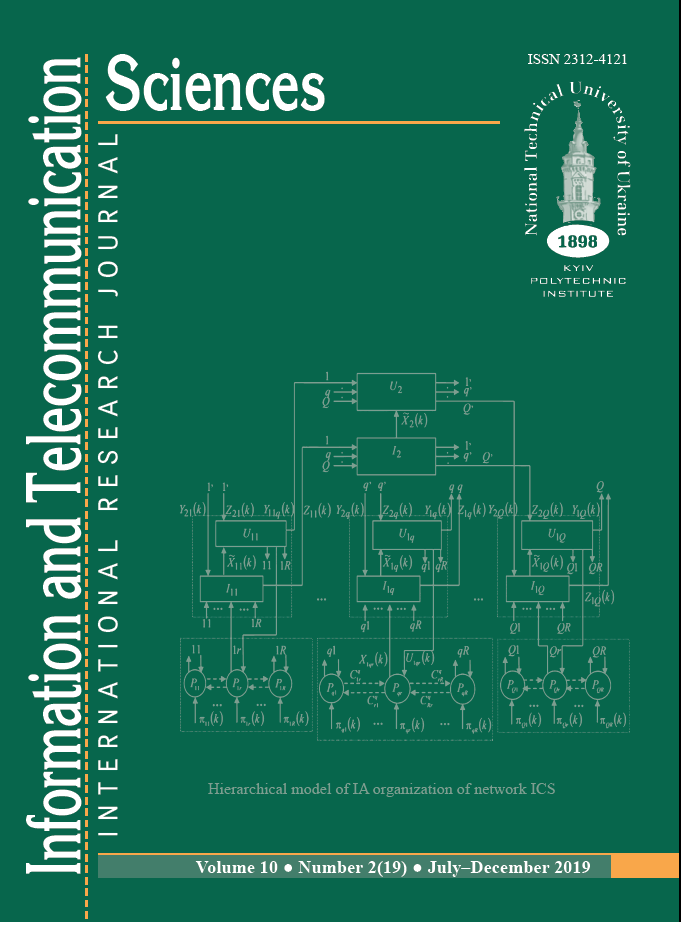WIRELESS COOPERATIVE RELAYING WITHOUT MAINTAINING A DIRECT CONNECTION BETWEEN THE SOURCE AND TARGET RECEIVER TERMINALS
DOI:
https://doi.org/10.20535/2411-2976.22019.5-11Keywords:
cooperative relaying, auxiliary repeater, wireless data transmission system, link characteristics, wireless terminal.Abstract
Background. Improving the efficiency of modern wireless systems requires the development of new wireless technologies and the introduction of new paradigms for building wireless networks, one of which is a distributed approach to network architectures. An important role here is played by the interaction between the wireless terminals or terminals and the base station through additional relay terminals. An important technology that implements this interaction in order to increase the efficiency of communication in a cell is cooperative relaying.
Objective. The aim of the paper is to increase the efficiency of cooperative relaying schemes of information by filling all time phases/slots entering synchronous transmission through the pair number of repeaters.
Methods. We study the structural and functional methods of building a wireless network.
Results. In order to increase the capacity of the traditional cooperative relay scheme, a scheme is proposed with the addition of another auxiliary relay to the existing one so that each of the relays operates only during one of its data transmissions phases. Mathematical models of a number of cooperative relay schemes have been developed, which allow us to describe the main radio technical characteristics of the schemes (SNR, BER and C). It is proposed that a decision regarding the inclusion of traditional cooperative relaying should occur when a certain distance is reached between the source and the target receiver, when the capacity with and without cooperative relaying are equal. Connecting a cooperative relay scheme without a direct connection allows not only increasing the SNR value, but also maintaining its level only with a slight decrease.
Conclusions. A new scheme of cooperative relaying without maintaining a direct connection between the source terminals and the target receiver is proposed. Compared to the traditional cooperative relay scheme, such a scheme demonstrates more stable radio link characteristics over a wide range of attenuation changes between the source and target receiver terminals.
References
Cooperative Communications for Improved Wireless Network
Transmission: Framework for Virtual Antenna Array Applications /
edited by M. Uysal. Hershey, New York: Information Science
Reference, 2010, 632 р. (ISBN 978-1-60566-665-5).
5G NR: The Next Generation Wireless Access Technology / edited by E. Dahlman, S. Parkvall, J. Skold, London: Academic Press, 2018, 468 р. (ISBN 978-0-12-814323-0).
Signal processing for 5G : algorithms and implementations / edited by Fa-L. Luo, C. Zhang, Chichester: John Wiley, 2016, 600 р. (ISBN 9781119116479).
M.Y. Ilchenko, S.O. Kravchuk, Telecommunication systems: Kyiv, Naukova dumka, 2017, 736 p. (ISBN: 978-966-00-1566-1), (in Ukraine).
Cooperative Communications and Networking, by edited K.J.R. Liu, A.K. Sadek, W. Su, A. Kwasinski, Cambridge: Cambridge University Press, 2009, 642 p. (ISBN-13 978-0-511-46548-2).
L.A. Afanasieva, S.O. Kravchuk, D.A. Minochkin, “Outage probability in wireless communication system with multiple antenna cooperative retransmission”, Scientific papers coll. of the Military Institute of Kyiv National University. Shevchenko, Issue 51, рр. 19-26 (2016).
L.O. Aphanasieva, S.O. Kravchuk, “Adaptive relay protocol for
cooperative networks”, Dig. of the 13th International Scientific conf. “Modern Challenges in Telecommunications”, april 15-19, 2019, Kyiv, Ukraine, – pp. 192-194 (2019)
(https://scholar.google.com.ua/scholar?oi= bibs&cluster=
&btnI=1&hl=uk)
L.O. Aphanasieva, S.O. Kravchuk, I.I. Shevchenko, K.I. Rystsova, “Coded cooperation scheme”, Dig. of the 12th International Scientific conf. “Modern Challenges in Telecommunications”, April 16-20, 2018, Kyiv, Ukraine, pp. 211-213 (2018)
(https://scholar.google.com.ua/scholar?oi=bibs&cluster=
&btnI=1&hl=uk).
A.V. Rizhko, S.O. Kravchuk, “Investigation of ability to increasing quality of service for IEEE 802.16j multishop repeater networks”, Dig. of the Eleventh International Scientific conf. “Modern Challenges in Telecommunications”, April 18-21, 2017, Kyiv, Ukraine, pp. 163-165 (2017)
(https://scholar.google.com.ua/scholaroi=bibs&cluster=11982547425195246610&btnI=1&hl=uk).
E. Zimmermann, P. Herhold, G. Fettweis, On the Performance of Cooperative Relaying Protocols in Wireless Networks, European
Transactions on Telecommunications 16(1), 5-16 January 2005, (DOI:10.1002/ett.1028).
P. Herhold, E. Zimmermann, G. Fettweis, “A Simple Cooperative Extension to Wireless Relaying”, International Zurich Seminar on Communications, 24 August, Zurich, Switzerland (2004) (DOI:10.1109/IZS.2004.1287382).
P. Kiratipongvooth, S. Sittichivapak, “Bit Error Probability of
Cooperative Diversity for M-ary QAM OFDM-based system with Best Relay Selection”, 2011 International Conference on Information and Electronics Engineering IPCSIT vol.6, IACSIT Press, Singapore, рр. 95-99 (2011).
E. Aydm, H. Illian, “SNR-based Relay Selection Scheme for
Cooperative Relay Networks”, International Wireless Communications & Mobile Computing Conference (IWCMC 2015), pp. 448-453 (DOI:10.1109/IWCMC.2015.7289125).
S.A. Kravchuk, “Comparison of ergodic bandwidth of traditional singlespan, multi-span and cooperative broadband radio access networks with relay”, Dig. of the Tenth International Scientific conf. “Modern Challenges in Telecommunications”, april 25-27, 2007, Kyiv, Ukrane. – K.: Himjest, 2007, р. 55.
Downloads
How to Cite
Issue
Section
License
The ownership of copyright remains with the Authors.
Authors may use their own material in other publications provided that the Journal is acknowledged as the original place of publication and National Technical University of Ukraine “Igor Sikorsky Kyiv Polytechnic Institute” as the Publisher.
ITS articles are published under Creative Commons licence:
- Authors retain copyright and grant the journal right of first publication with the work simultaneously licensed under CC BY 4.0that allows others to share the work with an acknowledgement of the work's authorship and initial publication in this journal.
- Authors are able to enter into separate, additional contractual arrangements for the non-exclusive distribution of the journal's published version of the work (e.g., post it to an institutional repository or publish it in a book), with an acknowledgement of its initial publication in this journal.
- Authors are permitted and encouraged to post their work online (e.g., in institutional repositories or on their website) prior to and during the submission process, as it can lead to productive exchanges, as well as earlier and greater citation of published work.

